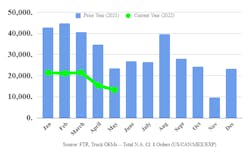Class 8 orders drop to lowest level since November 2021
After several level months, Class 8 truck and tractor orders slipped in May to their lowest in six months due to ongoing supply chain concerns and a predicted annual dip heading into summer, according to two commercial vehicle market research firms that each released preliminary data.
North American Class 8 net orders totaled 13,300 in May, which represents a 13% decrease compared to April and a 43% decrease compared to May 2021, according to preliminary data from FTR Transportation Intelligence. Another firm, ACT Research, measured May orders at 14,000 units. Class 8 orders have totaled 270,000 units over the last 12 months, a monthly average of 22,500.The first quarter of the year saw little variation in the number of heavy-duty truck orders, with numbers hovering around 21,000 per month, but activity has slowed leading into summer, “when orders tend to be seasonally weak,” Eric Crawford, ACT’s vice president and senior analyst, noted. “OEMs typically have yet to open their forward-year build schedules, as is currently the case for 2023.”
ACT analysis notes that because Class 8 backlogs stretch through 2022, OEMs have taken a conservative approach to heavy-duty orders, looking to limit the overbooking and underbuilding that hurt the industry last year.
Supply chain issues had improved in previous months, but “some of that progress stalled due to disruptions in China and Russia,” said Don Ake, FTR vice president of commercial vehicles. “The OEMs are not confident they can increase production in the second half of the year; therefore, they are not able to take more orders.”
OEMs are running out of build slots for the year, according to FTR. With supply chain shortages, especially semiconductors, they cannot increase 2022 build rates. OEMs are not taking many orders for 2023 because of inflated and variable component costs, making it difficult to give accurate quotes.
“Orders could even slide under 10,000 in the summer months before the cycle begins for next year,” Ake added.
“Demand for new trucks remains healthy,” Ake said. “[The amount of] freight is growing, and fleets need more trucks to keep up with customer demands and to trade in older vehicles. The supply of new trucks has been running way behind demand for over a year now and many fleets need to catch up to their replacement cycles.”
ACT also measured Classes 5-7 vehicles' net orders at 17,000 units for May.
ACT’s monthly State of the Industry: Classes 5-8 Vehicles Report and Data is available on their website, along with other reports. It contains current market data and analysis and historical data from 2000. FTR’s final May data will be available later in the month as part of its North American Commercial Truck & Trailer Outlook service.
About the Author
FleetOwner Staff
Our Editorial Team
Kevin Jones, Editorial Director, Commercial Vehicle Group
Josh Fisher, Editor-in-Chief
Jade Brasher, Senior Editor
Jeremy Wolfe, Editor
Jenna Hume, Digital Editor
Eric Van Egeren, Art Director

